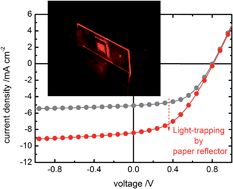Fully-solution-processed organic solar cells with a highly efficient paper-based light trapping element†
Abstract
We demonstrate the use of low cost paper as an efficient light-trapping element for thin film photovoltaics. We verify its use in fully-solution processed organic photovoltaic devices with the highest power conversion efficiency and the lowest internal electrical losses reported so far, the architecture of which – unlike most of the studied geometries to date – is suitable for upscaling, i.e. commercialization. The use of the paper-reflector enhances the external quantum efficiency (EQE) of the organic photovoltaic device by a factor of ≈1.5–2.5 over the solar spectrum, which rivals the light harvesting efficiency of a highly-reflective but also considerably more expensive silver mirror back-reflector. Moreover, by detailed theoretical and experimental analysis, we show that further improvements in the photovoltaic performance of organic solar cells employing PEDOT:PSS as both electrodes rely on the future development of high-conductivity and high-transmittance PEDOT:PSS. This is due optical losses in the PEDOT:PSS electrodes.


 Please wait while we load your content...
Please wait while we load your content...